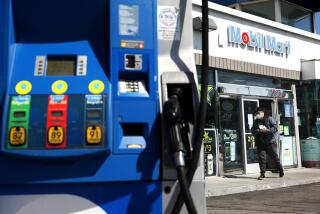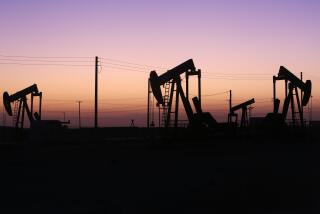Vast oil trove trapped in Monterey Shale formation
SHAFTER, Calif. — A bustling city is sprouting on five acres here, carved out of a vast almond grove. Tanker trucks and heavy equipment come and go, a row of office trailers runs the length of the site and an imposing 150-foot drilling rig illuminated by football-field-like lights rises over the trees.
It’s all been hustled into service to solve a tantalizing riddle: how to tap into the largest oil shale reservoir in the United States.
Across the southern San Joaquin Valley, oil exploration sites have popped up in agricultural fields and on government land, driven by the hope that technological advances in oil extraction — primarily hydraulic fracturing and acidization — can help provide access to deep and lucrative oil reserves.
The race began after the federal Energy Information Administration estimated in 2011 that more than 15 billion barrels of recoverable oil is trapped in what’s known as the Monterey Shale formation, which covers 1,750 square miles, roughly from Bakersfield to Fresno.
But getting at that oil isn’t easy. The Monterey Shale is unlike other oil shale formations across the United States. In those booming oil fields, reserves are pooled in orderly strata of rock. Once the rock is cracked open by fracking or other means, operators can sink a single well with multiple horizontal shafts and pull in oil from a wide area.
California’s geology is far more complicated. The earth under the Monterey Shale has undergone constant seismic reshaping that has folded, stacked and fractured the substrate, trapping the oil in accordion pleats of hard rock at depths of up to 12,000 feet. To reach the crude using conventional methods requires oil companies to drill far-deeper wells, and more of them — a prohibitively expensive undertaking.
To crack the code, companies are busily drilling test wells here, using various fracking and acidization techniques in search of cheaper solutions. So far, no one seems to have found a method to profitably extract the oil.
“Very smart engineers are spending their waking hours trying to come up with the magic formula,” said Rock Zierman, chief executive of the California Independent Petroleum Assn., a trade group that has many Monterey Shale prospectors among its members.
“What we do know is there is a heck of lot of oil down there,” Zierman said. “What we don’t know is how we can get it out of the ground in an economically viable way to justify the heavy investment.”
The shallow, 1,000-foot wells in the established Bakersfield oil patch might cost a hundred thousand dollars to sink. In the Monterey formation, that expense might run to $5 million, and with every chance of yielding a dry hole.
Despite the difficulty getting at the oil, the potential bonanza is too big for many oil companies to ignore.
In Kern County — where the bulk of the Monterey formation lies — available land for drilling has nearly all been snapped up. Speculators are believed to be responsible for driving up the cost of obtaining leases.
In 2007, the average successful bid for an acre of land for oil leasing went for $2, according to the federal Bureau of Land Management. The price has since soared above $500, with some recent parcels going for twice that. Oil companies drove up prices sharply in 2010, as various federal assessments began to hint at the magnitude of the Monterey reserves.
The leading edge of the exploration boom is pushing Bakersfield’s oil patch — which has reliably produced oil for more than 100 years — into long-established agricultural tracts. Oil companies are now paying farmers for their water rights, land and, in some cases, buying their homes outright to get at the reserves that might lie underneath.
Exploratory wells are sprouting near homes, schools and in the town of Shafter, where the city charges drillers to hook up to corner fire hydrants for the water they require. Companies are searching for the best well sites with 3D seismic “thumper trucks” that send shock waves underground to create a picture of subterranean deposits.
Should energy companies find a way to crack the Monterey’s deeply folded rock, the ensuing boom could be transformative for California. A USC economic study forecast an enormous impact: A Monterey-fueled oil shale industry could create 2.3 million new jobs by 2020 and boost the state’s GDP by as much as 14%.
The report, which was funded by the energy industry and published in 2013, projected that the Monterey formation had the potential to increase oil production in California sevenfold.
The implications are profound, touching on public health, water use, water quality and the loss of agricultural land. The subsequent transformation also would alter the lives of families living in the resolutely rural communities dotting the valley.
For Tom Frantz, a retired teacher and third-generation farmer, the exploratory drilling is already too much.
“This is prime farmland and they have drilled between 200 and 300 wells in the last 10 years in the Monterey Shale,” Frantz said. “Every one took out an acre or two of farmland. Every one has used hundreds of thousands of gallons of water. Each one has contributed to our air pollution. Each one has had spills on the ground of different chemicals and crude oil. Each one is emitting methane as we speak.
“If this thing happens and there are thousands and thousands of wells — that’s scary because an accident is bound to happen,” he said.
All the predictions — both enthusiastic and dire — are predicated on cracking into the stubborn Monterey formation.
David Hughes, a geoscientist at the Santa Rosa-based Post Carbon Institute, studied both the USC report and the federal data and then published his own assessment, which casts a skeptical eye on the rosy assumptions. His conclusion: “It’s not going to happen.”
Reviewing industry-generated data, Hughes said test wells in the Monterey so far have been expensive and unproductive.
“California oil production peaked in the early ‘80s,” Hughes said. “It’s now down to half that. If the Monterey Shale can just maintain California’s production level — I would think that’s about all it could do.”
The uncertainty has kept some of the industry’s heavy hitters on the sidelines. And although the big companies are loath to reveal their strategies, Chevron’s chief executive has said, “The jury’s out on Monterey Shale.”
Gabe Garcia, manager of the Bakersfield office of the BLM, which permits drilling on federal land, said no one has yet found enough accessible crude to make extraction profitable. “We’ve got areas where they’ve drilled several wells and they are still trying to prove economics to us,” Garcia said.
Any technology that succeeds will probably include either hydraulic fracturing — fracking — or acidizing. Fracking is a controversial but long-used technique that sends a high-pressure mixture of water, chemicals and sand into a well bore to explode the “tight” rock formation and free the oil. Acidizing entails shooting a potent mix of highly corrosive chemicals into the formation to dissolve the rock.
Both practices are under review by the state of California and the BLM and are, at the moment, unregulated.
Another aspect of fracking presents a unique challenge in California. The process of reinjecting drilling fluids into the ground is thought by some to stimulate minor seismic activity around drilling pads, dubbed “frackquakes.”
Fracking operations in Arkansas, Oklahoma and Pennsylvania have measured this phenomenon, but industry officials vigorously dispute the theory.
The San Andreas fault traces the western outline of the Monterey formation.
More to Read
Start your day right
Sign up for Essential California for news, features and recommendations from the L.A. Times and beyond in your inbox six days a week.
You may occasionally receive promotional content from the Los Angeles Times.







